Data
Hong Kong Road Infrastructure
Distribution and Length of Accessible Roads in Traffic Census - 2023
Hong Kong Island
Coverage ratio: 88.9%
Kowloon
Coverage ratio: 90.2%
New Territories
Coverage ratio: 85.4%
Total
Coverage ratio: 87.1%
Public Transport Statistics
Passenger Volume of Major Public Transport Modes in Hong Kong - 2023
Hong Kong Island
MTR
Passengers: +23.3% compared to 2022
New World Bus & Citybus
Passengers: +16.2% compared to 2022
Hong Kong Tramways
Passengers: +14.9% compared to 2022
Kowloon and New Territories
KMB
Passengers: +15.6% compared to 2022
MTR
Passengers: +24.5% compared to 2022
Cross-Harbour Public Transport Passenger Volume
MTR
+27.1% compared to 2022
Tunnel Buses
+9.4% compared to 2022
New World First Ferry
+7.6% compared to 2022
Star Ferry
+99.2% compared to 2022
Vehicle Registration and Licensing Information 2023
Total Licensed Vehicles
+0.6% compared to 2022
Total Registered Vehicles
-0.2% compared to 2022
Licensed Private Cars
+1.1% compared to 2022
Licensed/Registered Ratio
87.6% in 2022
2023 Vehicle Registration & Licensing Information
Total Licensed Vehicles
+0.6% vs 2022
Total Registered Vehicles
-0.2% vs 2022
Licensed Private Cars
+1.1% vs 2022
Licensed/Registered Vehicle Ratio
87.6% in 2022
Distribution of Charging Stations in Hong Kong Districts
Central and Western District
Fast: 54 (12.2%)
Medium: 377 (85.5%)
Slow: 10 (2.3%)
Eastern District
Fast: 78 (19.8%)
Medium: 299 (76.1%)
Slow: 16 (4.1%)
Islands District
Fast: 59 (12.9%)
Medium: 299 (65.3%)
Slow: 100 (21.8%)
Kowloon City District
Fast: 50 (22.7%)
Medium: 70 (31.8%)
Slow: 100 (45.5%)
Kwai Tsing District
Fast: 71 (28.0%)
Medium: 174 (68.5%)
Slow: 9 (3.5%)
Kwun Tong District
Fast: 154 (11.7%)
Medium: 607 (46.0%)
Slow: 559 (42.3%)
North District
Fast: 34 (7.1%)
Medium: 271 (56.8%)
Slow: 172 (36.1%)
Sai Kung District
Fast: 120 (29.1%)
Medium: 175 (42.4%)
Slow: 118 (28.5%)
Sha Tin District
Fast: 203 (14.9%)
Medium: 505 (37.1%)
Slow: 653 (48.0%)
Sham Shui Po District
Fast: 55 (21.7%)
Medium: 169 (66.8%)
Slow: 29 (11.5%)
Southern District
Fast: 59 (19.9%)
Medium: 231 (78.0%)
Slow: 6 (2.1%)
Tai Po District
Fast: 21 (12.6%)
Medium: 116 (69.4%)
Slow: 30 (18.0%)
Tsuen Wan District
Fast: 45 (14.2%)
Medium: 252 (79.2%)
Slow: 21 (6.6%)
Tuen Mun District
Fast: 61 (32.3%)
Medium: 116 (61.4%)
Slow: 12 (6.3%)
Wan Chai District
Fast: 78 (13.9%)
Medium: 410 (73.2%)
Slow: 72 (12.9%)
Wong Tai Sin District
Fast: 46 (20.1%)
Medium: 168 (73.4%)
Slow: 15 (6.5%)
Yau Tsim Mong District
Fast: 118 (33.6%)
Medium: 183 (52.1%)
Slow: 50 (14.3%)
Yuen Long District
Fast: 90 (25.4%)
Medium: 240 (67.6%)
Slow: 25 (7.0%)
Vehicle Distribution in Hong Kong Districts
Vehicle Type Distribution Statistics by District in 2023
Parking Space Distribution by District in Hong Kong
Central and Western
Private Cars: 52 (80.0%)
Goods Vehicles: 10 (15.4%)
Buses: 3 (4.6%)
Eastern District
Private Cars: 60 (100%)
Goods Vehicles: 0 (0%)
Buses: 0 (0%)
Southern District
Private Cars: 18 (78.3%)
Goods Vehicles: 0 (0%)
Buses: 5 (21.7%)
Wan Chai District
Private Cars: 68 (95.8%)
Goods Vehicles: 0 (0%)
Buses: 3 (4.2%)
Kowloon City District
Private Cars: 203 (88.3%)
Goods Vehicles: 6 (2.6%)
Buses: 21 (9.1%)
Kwai Tsing District
Private Cars: 30 (93.8%)
Goods Vehicles: 2 (6.2%)
Buses: 0 (0%)
Kwun Tong District
Private Cars: 12 (100%)
Goods Vehicles: 0 (0%)
Buses: 0 (0%)
North District
Private Cars: 26 (74.3%)
Goods Vehicles: 9 (25.7%)
Buses: 0 (0%)
Sai Kung District
Private Cars: 184 (94.4%)
Goods Vehicles: 11 (5.6%)
Buses: 0 (0%)
Sha Tin District
Private Cars: 172 (91.5%)
Goods Vehicles: 8 (4.3%)
Buses: 8 (4.2%)
Sham Shui Po District
Private Cars: 150 (100%)
Goods Vehicles: 0 (0%)
Buses: 0 (0%)
Tai Po District
Private Cars: 120 (98.4%)
Goods Vehicles: 2 (1.6%)
Buses: 0 (0%)
Tsuen Wan District
Private Cars: 45 (63.4%)
Goods Vehicles: 26 (36.6%)
Buses: 0 (0%)
Tuen Mun District
Private Cars: 65 (100%)
Goods Vehicles: 0 (0%)
Buses: 0 (0%)
Wong Tai Sin District
Private Cars: 20 (46.5%)
Goods Vehicles: 23 (53.5%)
Buses: 0 (0%)
Yau Tsim Mong District
Private Cars: 181 (76.7%)
Goods Vehicles: 40 (16.9%)
Buses: 15 (6.4%)
Yuen Long District
Private Cars: 2 (13.3%)
Goods Vehicles: 4 (26.7%)
Buses: 9 (60.0%)
Islands District
Private Cars: 5 (100%)
Goods Vehicles: 0 (0%)
Buses: 0 (0%)
Hong Kong Taxi Stands Distribution
Statistics of Various Types of Taxi Stands in 2023
Lantau Island Taxi Stands
3.9% of total
Cross-Harbour Taxi Stands
6.9% of total
Urban Taxi Stands
61.6% of total
Urban and Cross-Harbour Taxi Stands
0.2% of total
Urban and New Territories Taxi Stands
0.2% of total
New Territories Taxi Stands
13.3% of total
New Territories and Urban Taxi Stands
13.9% of total
Hong Kong Electric Vehicle Registration Trend
Changes in Electric Vehicle Registration Numbers 2020-2024
| Year | Total Registrations | Year-on-Year Growth |
|---|---|---|
| 2020 | 17,352 | - |
| 2021 | 26,833 | +54.6% |
| 2022 | 45,726 | +70.4% |
| 2023 | 73,494 | +60.7% |
| 2024 | 105,609 | +43.7% |
Property Price Index EPI
Hong Kong Real Estate Market Trends
Latest Release
106.52
Compared to Last Week
+0.27%
Compared to Last Month
-0.39%
Rental Index ERI
114.18
Compared to Last Week
-0.03%
Compared to Last Month
+0.45%
The latest issue is 2025/04/04, reflecting the secondary private residential property prices from 2025/03/21 - 2025/03/27 (period when provisional sale and purchase agreements/tenancy agreements were signed).
Hong Kong Electricity Suppliers Pricing
Service Areas and Tariff Standards of Hong Kong's Two Major Power Companies
CLP Power

Service Areas: Kowloon, New Territories and most outlying islands
HK Electric

Service Areas: Hong Kong Island, Ap Lei Chau and Lamma Island
Hong Kong EV Charging Facilities Analysis
Distribution of Charging Facilities and Future Development Trends
Comprehensive Analysis of Hong Kong's EV Charging Network
As of 2023, Hong Kong has 5,651 public charging stations covering all 18 administrative districts
Hong Kong is actively developing EV charging infrastructure as an important component of achieving carbon neutrality goals. Currently, Sha Tin District has the most charging stations (1,361), followed by Wan Chai District (560) and the Islands District (458). In terms of charging types, medium-speed chargers dominate, accounting for approximately 60% of the total, while fast chargers account for 18% and slow chargers account for 22%.
The government, in cooperation with private enterprises, plans to increase the number of public charging stations to 8,000 by 2025, with a focus on increasing the proportion of fast chargers to meet the growing demand for EV charging. Hong Kong's two major power companies, CLP and HK Electric, are also actively participating in the development of the charging network, providing different charging solutions and tariff plans.

Analysis of Charging Station Distribution Differences Across Hong Kong Districts
Uneven distribution of charging facilities, with significant differences between core urban areas and New Territories
The distribution of charging stations across Hong Kong districts shows significant imbalances. Sha Tin District leads with 1,361 charging stations, accounting for 24% of the total in Hong Kong, which aligns with its status as a major residential and commercial center in the New Territories. This is followed by Wan Chai District (560) and the Islands District (458), accounting for 9.9% and 8.1% of the total respectively.
In terms of charging type distribution, Hong Kong Island areas (Central and Western District, Eastern District, Southern District, and Wan Chai District) are dominated by medium-speed charging, with a lower proportion of fast charging, which is related to the high-density urban characteristics and space limitations. In contrast, New Territories areas (such as Sai Kung District and Yuen Long District) have a significantly higher proportion of fast chargers, reflecting the emphasis on fast charging needs in newly developed areas. It is worth noting that although Sha Tin District has the most charging stations, the proportion of slow chargers is as high as 48%, which may be related to its early deployment of charging facilities and urgently needs upgrading.

Distribution Characteristics of Fast, Medium, and Slow Charging Facilities
The layout of different charging types reflects urban functional zoning and user demand differences
The distribution of charging facility types in Hong Kong shows distinct functional differences. Fast charging stations (above 50kW) are mainly concentrated in transportation hubs, major shopping malls, and highway service areas. Yau Tsim Mong District (33.6%), Sai Kung District (29.1%), and Kwai Tsing District (28.0%) have the highest proportion of fast chargers, as these areas are often important commercial centers or major transportation routes.
Medium-speed charging stations (7kW-50kW) are currently the most mainstream charging type in Hong Kong, dominating in most areas, especially in Hong Kong Island areas such as Central and Western District (85.5%), Southern District (78.0%), and Eastern District (76.1%). These charging facilities are mainly deployed in shopping mall parking lots, public parking lots, and residential areas, suitable for 2-4 hour charging scenarios.
Slow charging stations (below 7kW) are mainly distributed in residential areas and workplaces. Sha Tin District (48.0%), Yuen Long District (45.5%), and Kowloon City District (45.5%) have high proportions of slow chargers, reflecting the common characteristics of residential communities in these areas, suitable for overnight long-duration charging.

Hong Kong EV Charging Costs and Electricity Rate Structure
CLP and HK Electric price differences and their impact on EV users
The cost of charging electric vehicles in Hong Kong is affected by the service areas of different power suppliers. CLP serves Kowloon, the New Territories, and most outlying islands, with a rate of 107.4 HK cents per unit; HK Electric serves Hong Kong Island, Ap Lei Chau, and Lamma Island, with a rate of 119.6 HK cents per unit, about 11.4% higher than CLP.
Taking common EV models as an example, a Tesla Model 3 with a battery capacity of 60kWh would cost approximately HK$64.4 for a full charge in the CLP area, while in the HK Electric area, it would cost HK$71.8. In comparison, the fuel cost for a similar class of gasoline vehicle to travel the same distance is typically between HK$120-150, demonstrating the significant energy cost advantage of electric vehicles.
The two power companies also offer different EV charging incentive programs. CLP's "Low Carbon Driving Scheme" provides preferential electricity rates during off-peak hours for registered users; HK Electric's "Smart Charge" program offers comprehensive charging facility installation and management services. As electric vehicles become more widespread, it is expected that more differentiated pricing schemes will be introduced in the future, further reducing the cost of using electric vehicles.

Future Development Plans for Hong Kong's EV Charging Network
Infrastructure planning for the government's goal of achieving full adoption of zero-emission vehicles by 2035
The Hong Kong SAR Government has set a target to stop selling traditional fuel vehicles by 2035. To support this goal, the expansion and upgrading of charging infrastructure is key. The government plans to increase the number of public charging stations from the current 5,651 to 15,000 in the next 5 years, with a focus on increasing the proportion of fast chargers to at least 30%.
In terms of regional distribution strategy, the focus will be on strengthening areas with relatively low charging station density, especially Tai Po District, Tuen Mun District, and Sham Shui Po District. At the same time, there are plans to build super-charging corridors along highways and major roads, with a high-power charging station every 15-20 kilometers to support long-distance electric vehicle travel.
In terms of charging technology, Hong Kong will gradually introduce ultra-high power charging facilities of 350kW and above to support the 10-15 minute fast charging needs of the new generation of electric vehicles. In addition, the application of vehicle-to-grid (V2G) bidirectional charging technology will be explored to integrate electric vehicles into renewable energy systems, achieving efficient energy utilization and grid stability.
